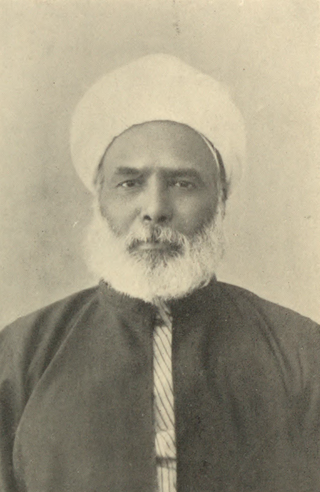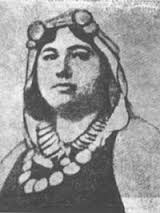Related Research Articles

Muḥammad ʿAbduh was an Egyptian Islamic scholar, judge, and Grand Mufti of Egypt. He was a central figure of the Arab Nahḍa and Islamic Modernism in the late 19th and early 20th centuries.
Al-Mu'ayyad was a daily newspaper published in Egypt in the period 1889 to 1900. It was one of the influential dailies of that period in Egypt.

Al-Hilal is a monthly Egyptian cultural and literature magazine founded in 1892. It is among the oldest magazines dealing with arts in the Arab world.

Malak Hifni Nasif was an Egyptian feminist who contributed greatly to the intellectual and political discourse on the advancement of Egyptian women in the early 20th century.
L'Égyptienne was a French language monthly women's magazine published in Cairo, Egypt, from 1925 to 1940. It was one of the earliest women's magazines and feminist periodicals in the country.
Hawaa is a weekly women's magazines published in Cairo, Egypt. The magazine is modelled by other women's magazines in the Arab countries. It was Egypt's first women's magazine, founded in 1954.

Al-Muqtaṭaf was an Arabic journal of popular science. The journal was published monthly from 1876 to 1952 in Beirut and Cairo with a total of 121 issues. Along with Al-Manar and Al-Hilal, it was one of the Arab world's three most popular journals in the early 20th century.
Amy Nimr (1898–1974), also known as Amy Smart, was an Egyptian-born artist, writer and patron of the arts. She is known for her association with the Cairo-based Art and Liberty Group.
Lotus was a trilingual political and cultural magazine which existed between 1968 and 1991. The magazine with three language editions was published in different countries: Egypt, Lebanon, Tunisia and German Democratic Republic. It contained one of the early postcolonial literary criticisms employing non-Eurocentric modes.
Al Dawa was an Arabic language monthly political magazine which was published in Egypt in two periods, 1951–1953 and 1976–1981. The publication was one of the media outlets connected to the Muslim Brotherhood in Egypt.
Al Liwa was an Arabic language newspaper which was published in Cairo, Egypt, in the period 1900–1912. It was the first mass circulation newspaper in the country. The paper was founded by Mustafa Kamil Pasha. From its start in 1900 to the death of its founder in 1908 Al Liwa adopted a nationalist political stance. Between 1907 and 1910 it was the official organ of the Watani Party which was also established by Mustafa Kamil Pasha. The paper adopted a pan-Islamist political stance between 1908 and 1910. Al Liwa was not affiliated with the Watani Party from 1910 to August 1912 when it was closed down.
Al Ustadh was an Arabic satirical, literary and political journal that was established by Abdullah Al Nadim in Cairo, Egypt, and published for eleven months in the period August 1892–June 1893. Although it was a short-lived publication, it played an important role in the development of short story genre in Arabic.
Al Muqattam was an Arabic newspaper which was published in Cairo, Egypt, between 1888 and 1952. It was one of the leading papers until its closure by the Egyptian government in 1954. The title of the paper was a reference to a range of hills outside Cairo.
Al Siyasa was an Egyptian newspaper which was the official media outlet of the now-defunct Liberal Constitutional Party. The paper was in circulation from 1922 to 1951.
Al Jarida was a liberal newspaper which was published in Cairo, Egypt, from 1907 to 1915. The paper was the official organ of the Umma Party. It was one of the publications that shaped the Egyptian nationalist culture containing the Westernized elements and was very influential during its existence.
Al Fath was a weekly political magazine which existed between 1926 and 1948 in Cairo, Egypt. The magazine is known for its cofounder and editor Muhib Al Din Al Khatib and for its role in introducing Hasan Al Banna, founder of the Muslim Brotherhood, to the Egyptian political life. It called itself as the mirror of the Islamic world.
Faris Nimr, was a pioneer Lebanese journalist and intellectual. He cofounded Al Muqattam, an Arabic, Cairo-based newspaper.
Al Jawaib was a newspaper which existed between 1861 and 1884. The paper was founded by Ahmad Faris al-Shidyaq, a Lebanese journalist, and headquartered in Constantinople, Ottoman Empire. Over time it became the most popular Arabic publication in the Empire and made its founder known as a respected journalist and writer. In the last year of its existence the paper was published in Cairo.
Rawdat Al Madaris, also known as Rawdat Al Madaris Al Misriyah, was a bimonthly education magazine which was published in Cairo, Egypt, between 1870 and 1877. It was the first Egyptian and Arab publication which specifically focused on education.
References
- ↑ Thierry Zarcone (2014). "Freemasonry and Islam". In Henrik Bogdan; J.A.M. Snoek (eds.). Handbook of Freemasonry. Vol. 8. Leiden: Brill. pp. 233–257. doi:10.1163/9789004273122_014. ISBN 9789004273122.
- 1 2 3 4 5 6 Byron D. Cannon (1985). "Nineteenth-Century Arabic Writings on Women and Society: The Interim Role of the Masonic Press in Cairo - (al-Lataif, 1885-1895)". International Journal of Middle East Studies . 17 (4): 463–484. doi:10.1017/S0020743800029433. S2CID 154672274.
- 1 2 3 Beth Baron (2005). Egypt As a Woman: Nationalism, Gender, and Politics. Berkeley, CA: University of California Press. p. 89. hdl:2027/heb04411.0001.001.
- ↑ Karim Wissa (1989). "Freemasonry in Egypt 1798-1921: A Study in Cultural and Political Encounters". Bulletin (British Society for Middle Eastern Studies). 16 (2): 146. JSTOR 195148.
- ↑ Donald M. Reid (October 1970). "Syrian Christians, the Rags-To-Riches Story, and Free Enterprise". International Journal of Middle East Studies. 1 (4): 361. doi:10.1017/S0020743800000738. S2CID 163113257.
- 1 2 3 Barbara De Poli (2021). "Italians, freemasons and the Dawn of Egyptian nationalism". The Journal of North African Studies. 27 (4): 4. doi:10.1080/13629387.2021.1891533. S2CID 233860784.
- ↑ Beth Baron (July 1989). "Unveiling in Early Twentieth Century Egypt: Practical and Symbolic Considerations". Middle Eastern Studies . 25 (3): 371. doi:10.1080/00263208908700787. JSTOR 4283318.
- ↑ Constantin Georgescu (1978). A Forgotten Pioneer of the Lebanese Nahdah: Salim al-Bustani (1848–1884) (PhD thesis). New York University. p. 38. ISBN 979-8-204-67080-8. ProQuest 302884803.